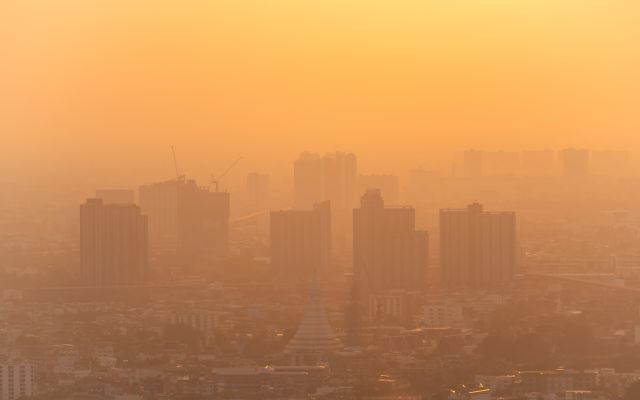Updated on August 16, 2023.
In the U.S. alone, nearly 188,000 new cases of dementia each year may be tied to air pollution, researchers estimate. People living in areas with high levels of a type of air pollution called PM2.5 could have a greater risk for neurodegenerative disease— chronic conditions that destroy parts of brain and other nerve cells over time, according to an August 2023 study published in JAMA Internal Medicine.
PM2.5, which is considered the most dangerous form of fine particulate matter, is a mixture of solid particles and liquid droplets in the air with diameters that are 2.5 micrometers and smaller—at least 30 times smaller than a single strand of average human hair, the U.S. Environmental Protection Agency (EPA) explains. These microscopic particles can linger in the air for extended periods of time. When inhaled, they could bypass the mucus and hairs in the nose, reaching deep into the lungs and the bloodstream causing inflammation and damage to vital organs. Since it’s so tiny, PM2.5 can invade the brain directly through the nose or cross the blood-brain barrier in other ways.
For the study, which was supported by the U.S. National Institutes of Health, scientists at the University of Michigan School of Public Health examined data on nearly 28,000 adults older than 50 from across the U.S. The researchers followed up with these participants every two years for a decade and analyzed their exposure levels to PM2.5 between 1998 and 2016. Even after adjusting for variables like income, education, age, sex, ethnicity, and other factors, they found that greater exposure to PM2.5 was associated with higher incident rates of dementia.
PM2.5 results from a range of sources, including road traffic, industry energy, and coal combustions. But the researchers noted the link between dementia and PM2.5 was strongest for exposure resulting from agriculture and wildfires.
The role of climate change
Air pollution from agriculture includes emissions from tractors and farm vehicles. But even greater sources of agricultural air pollution stem from neurotoxic pesticides or herbicide as well as the ammonium released into the air by livestock, manure, and fertilizer.
PM2.5 is also the main component of wildfire smoke. PM2.5 is responsible for the orange haze that shrouded many parts of the United States as Canadian wildfires raged out of control during the summer of 2023. As a result, the average American may have already inhaled more wildfire smoke in the first eight months 2023 than during any full year since 2006, according to an analysis by Stanford University researchers.
Wildfires have grown more intense and frequent due to climate change. The extent of area burned by wildfires each year has increased over the past 40 years, the EPA reports. Research also shows that changes in climate have created warmer, drier conditions, which have contributed to longer and more active fire seasons, according to the National Oceanic and Atmospheric Association (NOAA).
The University of Michigan researchers say they hope their findings prompt more targeted interventions to address this growing threat to public health. Taking action to mitigate certain air pollution sources, including wildfire smoke and agriculture, and cutting down on PM2.5 levels could help reduce the risk for dementia among populations.
It’s estimated are that about 5.8 million people in the United States have Alzheimer’s disease and related dementias, according to the Centers for Disease Control and Prevention (CDC). By 2060, the number of Alzheimer’s cases is predicted to surge to an estimated 14 million people, with minority populations being disproportionately affected.
Steps you can take to protect yourself
Being aware of the air quality in your local area is key to avoiding or minimizing your exposure to PM2.5 and other forms of fine particular matter.
Be sure to check your local air quality index (AQI). AQI levels range from 0 to 500. Levels of 100 or lower are generally considered acceptable but talk to your healthcare provider about what is safe and appropriate for you based on your age, health status, and other variables.
You can check your AQI at airnow.gov by entering your zip code. You can also sign up to get email or text alerts when air quality in your area becomes unhealthy. Some weather apps and local government websites also provide information on local air quality.
When air quality in your area is poor, the American Lung Association recommends taking the following steps:
- Avoid spending more than 30 minutes outdoors.
- If you do go outside, avoid strenuous activity or exercise and consider wearing a mask. Well-fitted N95 or KN95 masks are better able to filter particular matter than cloth or paper masks.
- Protect the quality of your indoor air by keeping your doors and windows closed.
- If you are using air conditioning, choose a setting that recirculates the indoor air.
- If possible, use a portable HEPA air cleaner to filter particulate matter from your indoor air.







